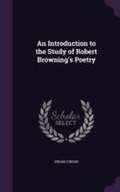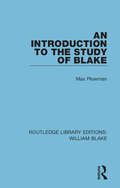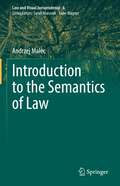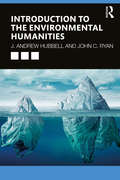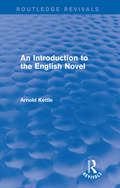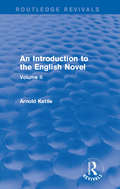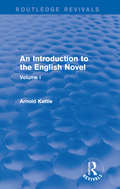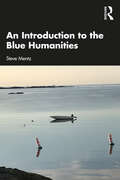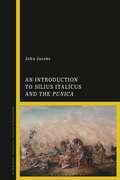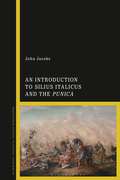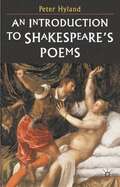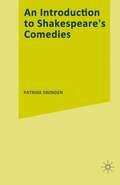- Table View
- List View
An Introduction to Twentieth-Century Czech Fiction: Comedies of Defiance
by Robert PorterA lucid and balanced appraisal of some of the best Czech fiction of the twentieth century.
An Introduction to the Study of Blake (Routledge Library Editions: William Blake)
by Max PlowmanFirst published in 1927 (this edition in 1967), this book is about Blake, his symbols, and their meanings. As Ward says in his forward, the volume goes beyond Blake, becoming universal and timeless, and is about Religion. Plowman’s book presents itself, not as a critical text, but an interpretative one, and the study therefore illuminates the work of the author, as well as that of William Blake.
An Introduction to the Study of Blake (Routledge Library Editions: William Blake #5)
by Max PlowmanFirst published in 1927 (this edition in 1967), this book is about Blake, his symbols, and their meanings. As Ward says in his forward, the volume goes beyond Blake, becoming universal and timeless, and is about Religion. Plowman’s book presents itself, not as a critical text, but an interpretative one, and the study therefore illuminates the work of the author, as well as that of William Blake.
Introduction to the Semantics of Law (Law and Visual Jurisprudence #6)
by Andrzej MalecThis book offers an introduction to the language of law from the perspective of logical semantics. As a logical tool, Boguslaw Wolniewicz’s formal ontology of situations is adapted. The central issue addressed is the meaning of normative statements, primarily legal norms. The main outcome of the book consists in explications of several legal notions (including legal events, legal acts and legal rules) in terms of the formal ontology of situations. In addition, the book concludes that legal norms are sentences in a logical sense, so some are true, while others are false, and that their logical value does not depend on whether or not they were adopted in the law-making process. Lastly, the book contends that there are semantic relations between orders that are similar to entailment, contradiction, opposition, and sub-opposition, despite the fact that orders are not sentences in a logical sense, i.e., they are neither true nor false.The book also presents some original Wittgenstein-style deontic logics built on the first order logic. The formal results are applied to selected problems in the theory of law, including the problem of the possibility of algorithmic application of legal norms.
An Introduction to the Russian Novel (Routledge Revivals)
by Janko LavrinIn this book, first published in 1943, Janko Lavrin provides an overview of the development of the Russian novel by placing the great Russian novelists – Tolstoy, Dostoevsky, Turgenev, Gorky, Gogol – in relation to their native literature and their social, political and cultural backgrounds. An Introduction to the Russian Novel will appeal particularly to students of Russian literature and culture as well as those interested in the development of the novel in general.
An Introduction to the Russian Novel (Routledge Revivals)
by Janko LavrinIn this book, first published in 1943, Janko Lavrin provides an overview of the development of the Russian novel by placing the great Russian novelists – Tolstoy, Dostoevsky, Turgenev, Gorky, Gogol – in relation to their native literature and their social, political and cultural backgrounds. An Introduction to the Russian Novel will appeal particularly to students of Russian literature and culture as well as those interested in the development of the novel in general.
An Introduction to The Gawain-Poet
by Ad PutterThe late 14th century produced a crop of brilliant writers: Chaucer, Langland and Gower. Their achievement was rivalled only by a series of four works generally agreed to have been written by a single northern author, known as the Gawain-Poet. This book introduces the reader to the Gawain-poet's four surviving works: Sir Gawain and the Green Knight, Patience, Pearl and Cleanness. The four poems are made accessible to the student by setting them in their relevant historical and cultural context and by developing some lines of critical argument. All studies are based on the author's own research and translations.
An Introduction to The Gawain-Poet
by Ad PutterThe late 14th century produced a crop of brilliant writers: Chaucer, Langland and Gower. Their achievement was rivalled only by a series of four works generally agreed to have been written by a single northern author, known as the Gawain-Poet. This book introduces the reader to the Gawain-poet's four surviving works: Sir Gawain and the Green Knight, Patience, Pearl and Cleanness. The four poems are made accessible to the student by setting them in their relevant historical and cultural context and by developing some lines of critical argument. All studies are based on the author's own research and translations.
An Introduction to the French Poets: Villon to the Present Day (Routledge Revivals)
by Geoffrey BreretonThe French poetry of some five centuries is here surveyed in a series of studies of the work and personality of individual poets from Villon to the present day. Each chapter is primarily concerned with establishing the ‘literary identity’ of the poet or poets with whom it deals: the work of each is outlined and related to the historical and biographical circumstances in which it was written; and its characteristics are then examined critically in terms relevant to the modern reader. Comparisons are made between different poets, and more general topics – such as the concepts of ‘classic’ and ‘baroque’ – are discussed. This book, first published in 1956, had become a standard introductory work for students of French poetry and general readers alike. For this revised edition, originally published in 1973, new chapters have been added on ‘irregular’ seventeenth-century poets and on various modern poets whose work now enables the Surrealist movement to be seen in clearer perspective. The bibliography has been revised extensively.
An Introduction to the French Poets: Villon to the Present Day (Routledge Revivals)
by Geoffrey BreretonThe French poetry of some five centuries is here surveyed in a series of studies of the work and personality of individual poets from Villon to the present day. Each chapter is primarily concerned with establishing the ‘literary identity’ of the poet or poets with whom it deals: the work of each is outlined and related to the historical and biographical circumstances in which it was written; and its characteristics are then examined critically in terms relevant to the modern reader. Comparisons are made between different poets, and more general topics – such as the concepts of ‘classic’ and ‘baroque’ – are discussed. This book, first published in 1956, had become a standard introductory work for students of French poetry and general readers alike. For this revised edition, originally published in 1973, new chapters have been added on ‘irregular’ seventeenth-century poets and on various modern poets whose work now enables the Surrealist movement to be seen in clearer perspective. The bibliography has been revised extensively.
Introduction to the Environmental Humanities
by J. Andrew Hubbell John C. RyanIn an era of climate change, deforestation, melting ice caps, poisoned environments, and species loss, many people are turning to the power of the arts and humanities for sustainable solutions to global ecological problems. Introduction to the Environmental Humanities offers a practical and accessible guide to this dynamic and interdisciplinary field. This book provides an overview of the Environmental Humanities’ evolution from the activist movements of the early and mid-twentieth century to more recent debates over climate change, sustainability, energy policy, and habitat degradation in the Anthropocene era. The text introduces readers to seminal writings, artworks, campaigns, and movements while demystifying important terms such as the Anthropocene, environmental justice, nature, ecosystem, ecology, posthuman, and non-human. Emerging theoretical areas such as critical animal and plant studies, gender and queer studies, Indigenous studies, and energy studies are also presented. Organized by discipline, the book explores the role that the arts and humanities play in the future of the planet. Including case studies, discussion questions, annotated bibliographies, and links to online resources, this book offers a comprehensive and engaging overview of the Environmental Humanities for introductory readers. For more advanced readers, it serves as a foundation for future study, projects, or professional development.
Introduction to the Environmental Humanities
by J. Andrew Hubbell John C. RyanIn an era of climate change, deforestation, melting ice caps, poisoned environments, and species loss, many people are turning to the power of the arts and humanities for sustainable solutions to global ecological problems. Introduction to the Environmental Humanities offers a practical and accessible guide to this dynamic and interdisciplinary field. This book provides an overview of the Environmental Humanities’ evolution from the activist movements of the early and mid-twentieth century to more recent debates over climate change, sustainability, energy policy, and habitat degradation in the Anthropocene era. The text introduces readers to seminal writings, artworks, campaigns, and movements while demystifying important terms such as the Anthropocene, environmental justice, nature, ecosystem, ecology, posthuman, and non-human. Emerging theoretical areas such as critical animal and plant studies, gender and queer studies, Indigenous studies, and energy studies are also presented. Organized by discipline, the book explores the role that the arts and humanities play in the future of the planet. Including case studies, discussion questions, annotated bibliographies, and links to online resources, this book offers a comprehensive and engaging overview of the Environmental Humanities for introductory readers. For more advanced readers, it serves as a foundation for future study, projects, or professional development.
An Introduction to the English Novel (Routledge Revivals: An Introduction to the English Novel)
by Arnold KettleFirst published in 1951, the two volumes of An Introduction to the English Novel discuss how and why the novel developed in England in the eighteenth century. The books look at the function and background of prose fiction, focusing its arguments around the study of carefully selected books that have had a significant impact on its development. The author examines the progress in the long struggle of the novelist to see life steadily and whole, and points out some of the problems and hazards that beset the writer still.
An Introduction to the English Novel: Volume II (Routledge Revivals: An Introduction to the English Novel)
by Arnold KettleFirst published in 1953, this book forms the second part of Arnold Kettle’s An Introduction to the English Novel. In this second part, Kettle builds a discussion of the modern English novel around the study of various books that have a more than casual significance in its development. He begins with an analysis of James, Hardy and Butler: three late Victorian writers whose work points forward to the major preoccupations of twentieth-century novelists. In his discussion of a dozen or so of these points, the author examines their progress in the long struggle of the novelist to see life steadily and whole, and points out some of the problems and hazards that beset the writer still. ‘The selection both of novelists and their work is excellent… it is both shrewd and witty…’ The Times Literary Supplement ‘Altogether this is a refreshing, challenging and original work, wholly adult in tone, and never pedantic or dull’ The Guardian
An Introduction to the English Novel: Volume I (Routledge Revivals: An Introduction to the English Novel)
by Arnold KettleFirst published in 1951 (this edition in 1967), this book forms the first part of Arnold Kettle’s An Introduction to the English Novel. Since the novel, like every other literary form, is a product of history, the book opens with a discussion of how and why the novel developed in England in the eighteenth century, as well as the function and background of prose fiction. The third part of the book examines six great novels from Jane Austen to George Eliot. ‘A serious and rewarding study.’ The Times Literary Supplement ‘His examination of some eighteenth century writers and analysis of six famous novels- from Emma to Middlemarch- have wit, authority and a sensitivity that compel the reader’s attention.’ Dublin Magazine
An Introduction to the English Novel: Volume II (Routledge Revivals: An Introduction to the English Novel)
by Arnold KettleFirst published in 1953, this book forms the second part of Arnold Kettle’s An Introduction to the English Novel. In this second part, Kettle builds a discussion of the modern English novel around the study of various books that have a more than casual significance in its development. He begins with an analysis of James, Hardy and Butler: three late Victorian writers whose work points forward to the major preoccupations of twentieth-century novelists. In his discussion of a dozen or so of these points, the author examines their progress in the long struggle of the novelist to see life steadily and whole, and points out some of the problems and hazards that beset the writer still. ‘The selection both of novelists and their work is excellent… it is both shrewd and witty…’ The Times Literary Supplement ‘Altogether this is a refreshing, challenging and original work, wholly adult in tone, and never pedantic or dull’ The Guardian
An Introduction to the English Novel: Volume I (Routledge Revivals: An Introduction to the English Novel)
by Arnold KettleFirst published in 1951 (this edition in 1967), this book forms the first part of Arnold Kettle’s An Introduction to the English Novel. Since the novel, like every other literary form, is a product of history, the book opens with a discussion of how and why the novel developed in England in the eighteenth century, as well as the function and background of prose fiction. The third part of the book examines six great novels from Jane Austen to George Eliot. ‘A serious and rewarding study.’ The Times Literary Supplement ‘His examination of some eighteenth century writers and analysis of six famous novels- from Emma to Middlemarch- have wit, authority and a sensitivity that compel the reader’s attention.’ Dublin Magazine
An Introduction to the Blue Humanities
by Steve MentzAn Introduction to the Blue Humanities is the first textbook to explore the many ways humans engage with water, utilizing literary, cultural, historical, and theoretical connections and ecologies to introduce students to the history and theory of water-centric thinking. Comprised of multinational texts and materials, each chapter will provide readers with a range of primary and secondary sources, offering a fresh look at the major oceanic regions, saltwater and freshwater geographies, and the physical properties of water that characterize the Blue Humanities. Each chapter engages with carefully chosen primary texts, including frequently taught works such as Herman Melville’s Moby-Dick, Samuel Taylor Coleridge’s “Rime of the Ancient Mariner,” Homer’s Odyssey, and Luis Vaz de Camões’s Lusíads, to provide the perfect pedagogy for students to develop an understanding of the Blue Humanities chapter by chapter. Readers will gain insight into new trends in intellectual culture and the enduring history of humans thinking with and about water, ranging across the many coastlines of the World Ocean to Pacific clouds, Mediterranean lakes, Caribbean swamps, Arctic glaciers, Southern Ocean rainstorms, Atlantic groundwater, and Indian Ocean rivers. Providing new avenues for future thinking and investigation of the Blue Humanities, this volume will be ideal for both undergraduate and graduate courses engaging with the environmental humanities and oceanic literature.
An Introduction to the Blue Humanities
by Steve MentzAn Introduction to the Blue Humanities is the first textbook to explore the many ways humans engage with water, utilizing literary, cultural, historical, and theoretical connections and ecologies to introduce students to the history and theory of water-centric thinking. Comprised of multinational texts and materials, each chapter will provide readers with a range of primary and secondary sources, offering a fresh look at the major oceanic regions, saltwater and freshwater geographies, and the physical properties of water that characterize the Blue Humanities. Each chapter engages with carefully chosen primary texts, including frequently taught works such as Herman Melville’s Moby-Dick, Samuel Taylor Coleridge’s “Rime of the Ancient Mariner,” Homer’s Odyssey, and Luis Vaz de Camões’s Lusíads, to provide the perfect pedagogy for students to develop an understanding of the Blue Humanities chapter by chapter. Readers will gain insight into new trends in intellectual culture and the enduring history of humans thinking with and about water, ranging across the many coastlines of the World Ocean to Pacific clouds, Mediterranean lakes, Caribbean swamps, Arctic glaciers, Southern Ocean rainstorms, Atlantic groundwater, and Indian Ocean rivers. Providing new avenues for future thinking and investigation of the Blue Humanities, this volume will be ideal for both undergraduate and graduate courses engaging with the environmental humanities and oceanic literature.
An Introduction to Silius Italicus and the Punica
by John JacobsIn a much-needed comprehensive introduction to Silius Italicus and the Punica, Jacobs offers an invitation to students and scholars alike to read the epic as a thoughtful and considered treatment of Rome's past, present, and (perilous) future. The Second Punic War marked a turning point in world history: Rome faced her greatest external threat in the famous Carthaginian general Hannibal, and her victory led to her domination of the Mediterranean. Lingering memories of the conflict played a pivotal role in the city's transition from Republic to Empire, from foreign war to civil war. Looking back after the events of AD 69, the senator–poet Silius Italicus identified the Second Punic War as the turning point in Rome's history through his Punica. After introductory chapters for those new to the poet and his poem, Jacobs' close reading of the epic narrative guides students and scholars alike through the Punica. All Greek and Latin passages are translated to ensure accessibility for those reading in English. Far more than simply a retelling of Rome's greatest triumph, the Punica challenges its reader to make sense of the Second Punic War in light of its full impact on the subsequent course of the city's history.
An Introduction to Silius Italicus and the Punica
by John JacobsIn a much-needed comprehensive introduction to Silius Italicus and the Punica, Jacobs offers an invitation to students and scholars alike to read the epic as a thoughtful and considered treatment of Rome's past, present, and (perilous) future. The Second Punic War marked a turning point in world history: Rome faced her greatest external threat in the famous Carthaginian general Hannibal, and her victory led to her domination of the Mediterranean. Lingering memories of the conflict played a pivotal role in the city's transition from Republic to Empire, from foreign war to civil war. Looking back after the events of AD 69, the senator–poet Silius Italicus identified the Second Punic War as the turning point in Rome's history through his Punica. After introductory chapters for those new to the poet and his poem, Jacobs' close reading of the epic narrative guides students and scholars alike through the Punica. All Greek and Latin passages are translated to ensure accessibility for those reading in English. Far more than simply a retelling of Rome's greatest triumph, the Punica challenges its reader to make sense of the Second Punic War in light of its full impact on the subsequent course of the city's history.
An Introduction to Shakespeare's Poems
by Peter HylandAn Introduction to Shakespeare's Poems provides a lively and informed examination of Shakespeare's non-dramatic poetry: the narrative poems Venus and Adonis and The Rape of Lucrece; the Sonnets; and various minor poems, including some only recently attributed to Shakespeare. Peter Hyland locates Shakespeare as a sceptical voice within the turbulent social context in which Elizabethan professional poets had to work, and relates his poems to the tastes, values and political pressures of his time. Hyland also explores how Shakespeare's poetry can be of interest to twenty-first century readers.

